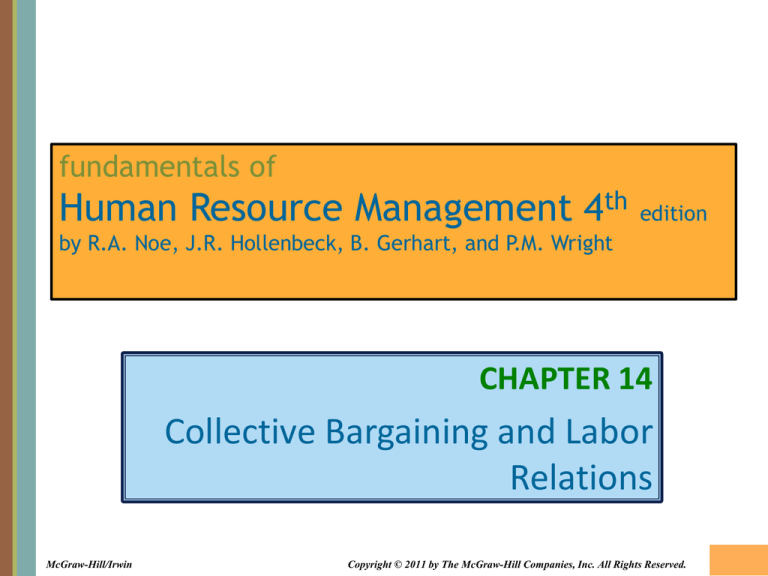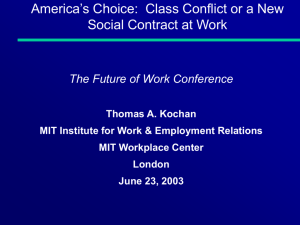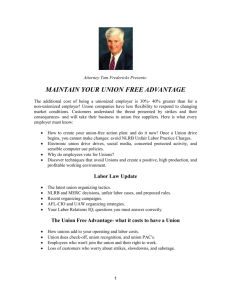
fundamentals of
Human Resource Management 4th
edition
by R.A. Noe, J.R. Hollenbeck, B. Gerhart, and P.M. Wright
CHAPTER 14
Collective Bargaining and Labor
Relations
McGraw-Hill/Irwin
Copyright © 2011 by The McGraw-Hill Companies, Inc. All Rights Reserved.
14-1
What Do I Need to Know?
1. Define unions and labor relations and their
role in organizations.
2. Identify the labor relations goals of
management, labor unions, and society.
3. Summarize laws and regulations that affect
labor relations.
4. Describe the union organizing process.
14-2
What Do I Need to Know? (continued)
5. Explain how management and unions
negotiate contracts.
6. Summarize the practice of contract
administration.
7. Describe more cooperative approaches to
labor-management relations.
14-3
Role of Unions
• In the U.S., most workers act as individuals to
select jobs that are acceptable to them and to
negotiate pay, benefits, flexible hours, and
other work conditions.
• At times, workers have believed their needs
and interests do not receive enough
consideration from management.
• One response by workers is to act collectively
by forming and joining labor unions.
14-4
Unions and Labor Relations
• Unions – organizations
formed for the purpose
of representing their
members’ interests in
dealing with employers.
• Labor relations – field
that emphasizes skills
managers and union
leaders can use to
minimize costly forms of
conflict (such as strikes)
and seek win-win
solutions to
disagreements.
14-5
Labor relations involves three levels of
decisions:
1. Labor relations strategy
2. Negotiating contracts
3. Administering contracts
14-6
National and International Unions
• Most Union members belong to a national or
international union. These unions may be:
– Craft unions: labor unions whose members all
have a particular skill or occupation.
– Industrial unions: labor unions whose members
are linked by their work in a particular industry.
• Most national unions are affiliated with the
American Federation of Labor and Congress
of Industrial Organizations (AFL-CIO).
14-7
Figure 14.1: 10 Largest Unions in the
United States
14-8
Figure 14.2: Union Membership Density among
U.S. Wage and Salary Workers, 1973-2009
14-9
The decline in union membership has
been attributed to:
Change in the structure of the
economy
Management efforts to control
costs
Human resource practices
Government regulation
14-10
Figure 14.3: Union Membership Rates and
Coverage in Selected Countries
14-11
Many Union Workers Hold
Government Jobs
14-12
Impact of Unions on Company
Performance
• Harley-Davidson and the
International Association of
Machinists and Aerospace
Workers have cooperated to
produce good results.
• In general, though,
companies wishing to
become more competitive
need to continually monitor
their labor relations
strategies.
14-13
Goals of Management
• Management goals are to increase the
organization’s profits. Managers tend to prefer
options that lower costs and raise output.
• When an employer has recognized a union,
management’s goals continue to emphasize
restraining costs and improving output.
• Managers prefer to keep their organization’s
operations flexible.
14-14
Goals of Management (continued)
• In their labor relations, managers prefer to:
– Limit increases in wages and benefits, and
– Retain as much control as they can over work
rules and schedules.
14-15
Goals of Labor Unions
• Labor unions have the goals of obtaining pay
and working conditions that satisfy their
members and of giving members a voice in
decisions that affect them.
• They obtain these goals by gaining power in
numbers.
• Unions want to influence the way pay and
promotions are determined.
14-16
Goals of Labor Unions (continued)
• The survival and security of a union depend
on its ability to ensure a regular flow of new
members and member dues to support the
services it provides.
• Unions place high priority on negotiating two
types of contract provisions that are critical to
a union’s security and viability:
– Checkoff provisions
– Union membership or contribution provisions
14-17
Goals of Labor Unions (continued)
Checkoff Provision
• Contract provision
under which the
employer, on behalf of
the union,
automatically deducts
union dues from the
employees’ paychecks.
Membership Security
• Closed shop
• Union shop
• Agency shop
• Maintenance of
membership
14-18
Goals of Society
• The activities of unions and management take
place within the context of society.
• Society’s values drive the laws and regulations
that affect labor unions.
• Society’s goal for unions is to ensure that
workers have a voice in how they are treated
by their employers.
14-19
Laws Affecting Labor Relations
National Labor Relations Act
(NLRA) of 1935
Taft-Hartley Act of 1947
Landrum-Griffin Act of 1959
14-20
Laws Affecting Labor Relations (continued)
• Right-to-work laws:
state laws that make
union shops,
maintenance of
membership, and
agency shops illegal.
• National Labor
Relations Board
(NLRB): Federal
government agency
that enforces the NLRA
by conducting and
certifying
representation
elections and
investigating unfair
labor practices.
14-21
Figure 14.4:
States with Right-to-Work Laws
14-22
Test Your Knowledge
True (A) or False (B)
1. The NLRA established unfair labor practices on the part
of the union.
2. The NLRB determines which states are Right-to-Work
3. In Right-to-Work states, employees do not have to
become members of the union
4. In states without Right-to-Work laws unions can refuse
to hire non-union members.
5. Protection from union misconduct was established by
the Landrum-Griffin Act.
14-23
The Process of Organizing
Signing authorization cards
Petition for election
Election campaign
Election and certification
14-24
Signing Authorization Cards
• A document indicating that an employee
wants to be represented by a labor
organization in collective bargaining
• Is there sufficient interest on the part of
employees to justify the unit
• Evidence of interest when at least 30 percent
of the employees in a work group sign an
authorization card
• Usually need 50% to proceed
14-25
Figure 14.5:
Example of an Authorization Card
14-26
Petition for Election
• After authorization cards have been signed, a
petition for election is made to the regional
NLRB office
• NLRB will ordinarily direct that an election be
held within 30 days
14-27
Election and Certification
• NLRB monitors the secret-ballot election on
the set date
• Board will issue a certification of the results to
the participants
• Majority of the employees vote for union.
NLRB will certify.
• Process does not require either party to make
concessions; it only compels them to bargain
in good faith
14-28
Table 14.1: What Supervisors Should and
Should Not Do to Discourage Unions
14-29
Union Strategies
• Organizers call or visit employees at home to
talk about issues like pay and job security.
• Offer workers associate union membership.
• Conduct corporate campaigns.
• Negotiate employer neutrality and card-check
provisions into a contract.
14-30
Union Decertification
• Taft-Hartley Act made it possible for
employees to decertify a union
• Essentially the reverse of the process that
employees must follow to be recognized as an
official bargaining unit
• Employees have used decertification petitions
with increasing frequency and success
14-31
Decertification Procedure
• At least 30 percent must petition for election
• Petition submitted 60-90 days prior to
expiration of current contract
• Schedule decertification election
• If majority votes against union, employees will
be union free
14-32
Collective Bargaining
• In collective bargaining a union negotiates on
behalf of its members with management
representatives to arrive at a contract defining:
– Recognition
– Management Rights
– Union Security
– Compensation and Benefits
– Grievance Procedure
– Employee Security
14-33
Table 14.2: Typical Provisions in Collective
Bargaining Contracts
14-34
Test Your Knowledge: Which of the Following
is an Unfair Labor Practice (ULP)?
1. Enforcing disciplinary policies only to those who have
expressed interest in a union
2. Showing employees articles about negative aspects of unions
that occurred elsewhere
3. Email employees asking them to respond with how they plan
to vote in the union election
4. Tell employees the disadvantages of having a union
5. Enforcing disciplinary policies when deserved to a pro-union
employee
6. Promise employees an additional week of vacation if they
vote against the union
14-35
Bargaining Over New Contracts
Distributive Bargaining
Integrative Bargaining
Attitudinal Bargaining
Intraorganizational Bargaining
14-36
When Bargaining Breaks Down
Strikes
• Strike: a collective
decision by union
members not to work
until certain demands
or conditions are met.
Alternatives to Strikes
• Mediation
• Fact Finder
• Arbitration
14-37
Figure 14.6:
Strikes Involving 1,000 or More Workers
14-38
Alternatives to Strikes
Mediation
Fact Finder
Arbitration
• Conflict resolution
procedure in
which a mediator
hears the views of
both sides and
facilitates the
negotiation
process but has
no formal
authority to
dictate a
resolution.
• Third party to
collective
bargaining who
reports the
reasons for a
dispute, the views
and arguments of
both sides, and
possibly a
recommended
settlement, which
the parties may
decline.
• Conflict resolution
procedure in
which an
arbitrator or
arbitration board
determines a
binding
settlement.
14-39
Contract Administration
Contract Administration
• Includes carrying out
the terms of the
agreement and
resolving conflicts over
interpretation or
violation of the
agreement.
Grievance Procedure
• The process for
resolving unionmanagement conflicts
over interpretation or
violation of a collective
bargaining agreement.
14-40
Figure 14.7: Steps
in an EmployeeInitiated Grievance
Procedure
14-41
Labor-Management Cooperation
Employee involvement in decision
making
Self-managing employee teams
Labor-management problem-solving
teams
Broadly defined jobs
Sharing of financial gains and business
information with employees
14-42
Test Your Knowledge
True (A) or False (B)
1. Mediation requires each party to abide by the
mediator’s decision.
2. Clearly written contracts require less contract
administration time due to fewer disagreements over
interpretation.
3. Integrative bargaining involves a win-lose approach
because the issues are considered a fixed pie.
4. A union steward represents the issues concerning
union employees and is elected by them.
14-43
Summary
• A union is an organization formed for the purpose of
representing its members in resolving conflicts with
employers.
• Labor relations is the management specialty
emphasizing skills that managers and union leaders
can use to minimize costly forms of conflict and to
seek win-win solutions to disagreements.
• Management goals are to increase the organization’s
profits. Managers generally expect that unions will
make these goals harder to achieve.
14-44
Summary (continued)
• Labor unions have the goal of obtaining pay and
working conditions that satisfy their members. They
obtain these results by gaining power in numbers.
• Society’s values have included the hope that the
existence of unions will replace conflict or violence
between workers and employers with fruitful
negotiation.
• In contrast to the traditional view that labor and
management are adversaries, some organizations
and unions work more cooperatively.
14-45







